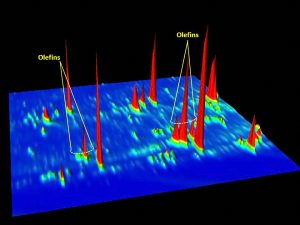GoMRI Research Board Invitation: Participate in QA/QC Analytical Chemistry Experiment
– June 16, 2014
The Gulf of Mexico Research Initiative (GoMRI) in cooperation with the National Institute of Standards and Technology (NIST) has launched the Hydrocarbon Inter-calibration Experiment (HIE) to address the need for advancing the importance of laboratory Quality Assurance/Quality Control (QAQC) practices and for inter-laboratory comparison and calibration for petroleum compounds.
The purpose of this experiment is to facilitate the best science possible on hydrocarbon analysis, through improved refinement of reference analytics and levels.
The GoMRI Research Board strongly encourages GoMRI-funded Principal Investigators, Co-Principal Investigators, and other GoMRI collaborating laboratories who are involved in hydrocarbon analysis to participate in the HIE and address this very important and pressing issue. The Board and project leaders also invite other members of the scientific community to participate. Project participants will be supplied with two different reference samples (approximately July 15, 2014) for analysis. Analysis and data submission will be in the early winter of 2014. An in-depth discussion of results, practices, and lessons learned will be held during the 2015 Gulf of Mexico Ecosystems Science Conference (http://www.cvent.com/events/2015-oil-spill-and-ecosystem-science-conference/event-summary-f8e7997d3673455e8ae8ebd03a854af1.aspx)
To Participate
If you are interested in participating, you must be willing to:
- Analyze and report results by December 1, 2014,
- Share information on analytical methods used,
- Allow the NIST and GOMRI to use your results (participants will be identified as a group, but lab specific results will be anonymous),
- Be open to co-author a peer-reviewed manuscript, and
- Make a significant effort to attend a workshop to discuss the results of this study at the 2015 GOMRI meeting in Houston, TX (February 16, 2015).
Those interested must sign up through Survey Monkey.
Background
On January 26, 2014, the GoMRI convened a QA/QC for Petroleum Compounds workshop attended by experts in various subfields of oceanography and chemistry. This very important effort was discussed at the Hydrocarbon Chemistry QA/QC meeting during the 2014 Gulf of Mexico Oil Spill and Ecosystem Science Conference. The purpose of the meeting was to discuss the current state of knowledge with regard to hydrocarbon chemical analysis, with the goal of elucidating best principles for assessing and confirming quality hydrocarbon analysis data as well as ways to improve current methodologies. A summary, the presentations, and relevant articles discussed at the meeting can be found at: https://gulfresearchinitiative.org/hydrocarbon-intercalibration-experiment/.
Inter-comparison exercises are an excellent tool for assessing the comparability of analytical measurements. In addition, they also provide an opportunity for researchers to compare their methods and approaches as well as report on novel or typically untargeted analytics that may eventually become more standard because of their importance to tracking spilled oil, and understanding fates and effects of spilled oil. For example, recent studies have identified in weathered samples an increase in oxygen in the oil residues on bulk sample, class of chemicals, and molecular levels using non-traditional techniques.
The HIE study samples include “fresh” crude oil from the Macondo well and “field weathered” oil residue collected from an Alabama beach in 2012. An existing and a candidate Standard Reference Material (SRM) will be distributed from the National Institute of Standards and Technology (NIST), i.e, SRM 2779 Gulf of Mexico Crude Oil and SRM 2777 Weathered Gulf Of Mexico Oil, respectively.
Analyses will target traditional petroleum hydrocarbons, including normal, branched, cyclic alkanes; naphthenoaromatics; polycyclic aromatic hydrocarbons; and steranes, hopanes, and triaromatic steroid hydrocarbons. We invite you to provide other analytical results and characteristics determined in your laboratory, such as bulk-property characterization or even toxicological assays (and list what you may add in the response form).
For More Information
Please visit https://gulfresearchinitiative.org/hydrocarbon-intercalibration-experiment/ which contains the agenda, summary, presentations and reference documents discussed at the Mobile 2014 Hydrocarbon QA/QC Meeting. If you have any other questions please contact the project leaders at gomri-hie@aibs.org. Once the group is established specific details will follow and information will be posted at the above website.
************
The Gulf of Mexico Research Initiative (GoMRI) is a 10-year independent research program established to study the effect, and the potential associated impact, of hydrocarbon releases on the environment and public health, as well as to develop improved spill mitigation, oil detection, characterization and remediation technologies. An independent and academic 20-member Research Board makes the funding and research direction decisions to ensure the intellectual quality, effectiveness and academic independence of the GoMRI research. All research data, findings and publications will be made publicly available. The program was established through a $500 million financial commitment from BP. For more information, visit https://gulfresearchinitiative.org/.
© Copyright 2010-2017 Gulf of Mexico Research Initiative (GoMRI) – All Rights Reserved. Redistribution is encouraged with acknowledgement to the Gulf of Mexico Research Initiative (GoMRI). Please credit images and/or videos as done in each article. Questions? Contact web-content editor Nilde “Maggie” Dannreuther, Northern Gulf Institute, Mississippi State University (maggied@ngi.msstate.edu).






